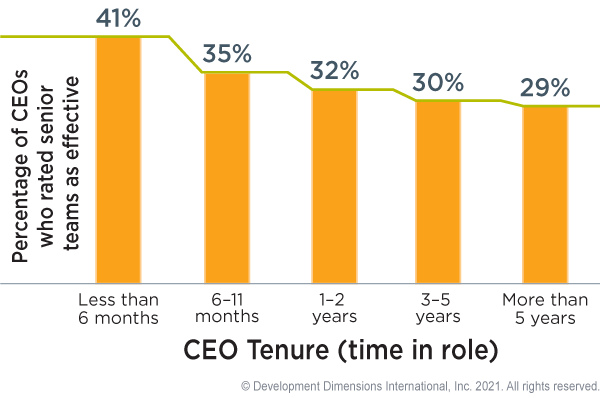“What no one tells you before you become a CEO is how hard it is to manage your C-suite team. You’ve got this group of very impressive people with long lists of accomplishments, and yet getting them to truly work together and share accountabilities is incredibly difficult.”
One of our CEO clients shared this about the performance of his team. At the time, we’d just shared some new data from our CEO Leadership Report showing that CEOs lose confidence in their C-suite teams over time.

It sparked something in him, and much of our work together is aimed at tackling the challenges of leading the C-suite. How, he asked, can such a stellar group of individuals struggle so much as a team?
This is an increasingly common topic among all of us as DDI executive coaches, and we’ve recently begun to investigate further. What is happening in the C-suite that holds teams back? What are the early signs of dysfunction? And what can CEOs do to address challenges before it’s too late?
What CEOs Think of Their C-Suite Teams
As we summarized themes across CEOs and their C-suite teams, here’s what they told us:
- It’s very difficult to quickly understand the team. One CEO shared that evaluating the strength of his senior team is one of his most difficult and ambiguous tasks. It takes time, and it’s easy to overestimate strength until there’s been ample opportunity to see how teams translate priorities into action (or don’t). His perception of the strength of his team changed “almost 180 degrees” in the first year. And he was hired from inside the company.
- Plan for the “honeymoon” to end. Another CEO described “a honeymoon period," and more importantly, that it was only after that period that he truly understood the team he had working for him. Having joined from outside, he thought he had a good read of the team’s capability. But after six months, he came to learn that he had significantly overestimated them. When he started, he anticipated changing one to two players. But by the time he reached his third year, he had moved or replaced every player but one.
- The stronger the players, the harder it can be for them to work together. A third CEO said this: “I have the best leaders in the business. If I could only get them to work together.” Most executives make it to the C-suite with one main thing in their past: success. Often their individual achievements cause them to form strong beliefs and habits. But in the C-suite, these preconceived notions often need to take a back seat so that accountabilities and assignments can be aligned in ways that create change and progress across the entire organization. Many C-suite executives don’t expect to have to collaborate and adjust as much as is required at the top, and few CEOs are equipped with the skills to facilitate and steer a team of superstars toward a unified direction.
- No team will stay effective long-term without a shock to the system. A fourth CEO, nearing retirement, reflected on the major business transformation his organization had undergone. His reaction was simple. He felt that five years is a long time, and that most teams can’t stay effective for that long if they don’t change significantly (and most don’t, he added). At times it is necessary for CEOs to jump-start the system by creating change that startles leaders into new ways of creating momentum and action.
One shared perception among all the CEOs was that taking an accurate pulse of team strength should be a top priority from day one. The moment the team starts to fall apart, you lose your effectiveness as a CEO.
In some cases, problems stem from underperforming individuals, for which the remedies are more straightforward. But more often, small dysfunctional team dynamics grow into significant team performance problems. Rarely does this rise to the level of public drama (although certainly it can). More often, there are subtler cues that a team is devolving into dysfunction.
6 Signs of Dysfunction in the C-Suite
As we talked with CEOs and CHROs, we found six common signals that often indicate deeper challenges with the effectiveness of their C-suite teams:

1. Unexpected Departures
As the Great Resignation hit the C-suite, we’ve seen a lot more churn than usual. While a small amount of turnover can help bring in new ideas, some C-suites are seeing so much turnover that it’s disrupting team trust and continuity. This is particularly disruptive when no one sees it coming.

2. Siloed Focus
Many C-suites operate much more as a group of individuals focused on their own goals, rather than as a team with shared goals and accountabilities. They are determined to hit their metrics, regardless of what’s happening outside of their part of the organization. While individual performance is high, CEOs struggle to move the needle on overall company performance.

3. Stagnating Performance
We hear from a lot of CEOs that it’s not that their teams are underperforming per se, but they just have no momentum for innovation and change. This can happen for a lot of reasons – exhaustion, a large portion of the executive team nearing retirement, stuck in old ways of doing things, etc. But it’s a quick path to becoming obsolete.

4. Tenuous Trust
We’ve seen this happen many, many times in C-suites: A few people (usually with the highest titles) do all the talking. No one disagrees with them. But as everyone leaves the room, nobody is really on board. But they don’t trust one another enough to share candid – but crucial – feedback, concerns, and ideas. They’re too afraid of how others will react. As a result, progress is extremely slow.

5. New Guard vs. Old Guard
In line with the rapid turnover we’re seeing, a lot of C-suites are experiencing pain as the new members clash with long-tenured executives. The new executives are often eager to prove their value, and quickly make changes. Meanwhile, experienced members of the C-suite may feel that proposed changes are a direct criticism of their leadership, and may not respect executives who are newly promoted or new to the business and industry. These tensions can lead to dramatically different views and priorities around the company’s vision and direction.

6. Distanced Disconnect
Just like everyone else, many C-suites are feeling the strain of remote work on their teams. While in some companies (especially multinationals) executives are used to collaborating from a distance, other executives have depended on face-to-face interactions to build their relationships. As fewer companies are requiring their executives to be headquartered in a single location, some C-suites are deeply feeling the disconnect.
Getting Past the Dysfunction of Your C-Suite
Let’s be honest: Unless there are major battles happening, most C-suites are reluctant to address the dysfunction on their team. Many assume these issues go with the territory, and prioritize other matters. Or they may be a bit cynical that things will improve much. Or in some cases, they’re afraid of the feedback they may get.
But in our conversations with CEOs, one of their biggest regrets was waiting to address dysfunction in the C-suite. Without clarity and cohesion, their teams spent too long spinning their wheels, costing the company major opportunities and potentially sending them down the wrong paths. And it reflects poorly on the CEO, who can’t seem to advance their agenda.
So what do you do about it? It usually requires some kind of jolt to the system, followed by ongoing development. But it starts by appropriately assessing where your team is, and applying the right approaches from there.
In our experience, successful C-suites go through cycles of development every few years that may look something like the graphic below:

Of course, not all journeys are linear, or start at the beginning. And there’s no one-size-fits-all solution for the complexity of C-suite dynamics.
However, we find it can be helpful to start out with a few simple questions to know where you are on this journey. Then you can begin action on some potential solutions to start addressing your challenges.
Set the vision
You may be here if:
- You recently shifted your business strategy.
- You’ve recently been through a merger acquisition, or restructuring.
Questions to ask:
- What key things does our C-suite need to do to drive our most critical business priorities for the next few years?
- Are we looking beyond past performance to ensure that our executives are equipped to drive us where we need to go next?
What to do about it:
- Conduct stakeholder interviews: Whether done internally or with an external consultant, ask individual stakeholders about what they believe are the top business priorities. Find out what skills they believe are most critical in the C-suite, and what may be lacking.
- Identify your top challenges: Based on the data from the stakeholder interviews, identify the top three to four challenges that are MOST crucial to your success in the next few years. Note that there will always be much more, but try to focus on only the most critical ones. From there, connect key skills and competencies that drive success in that area.
- Hold a team strategy and alignment session: Bring the C-suite team together to ensure that everyone aligns on the prioritization of the team’s challenges.
Make the tough people decisions
You may be here if:
- A shift in strategy has radically changed the requirements of key roles.
- You are seeing performance drops in key areas.
- There’s discord among the senior team.
Questions to ask:
- Do you have the right people in the right jobs with the right capabilities?
- Is there anyone in a key role that is serving as a barrier to success?
- Are there new roles you need to add to the team to support your strategy, i.e. a Chief Commercial Officer, Chief Diversity Officer, etc.?
What to do about it:
- Get data on your C-suite’s capabilities: It’s crucial that you make decisions based on data about each individual’s capabilities, rather than gut feelings about who’s right in the job and who’s not. You can use assessments such as a business simulation or an interview assessment to get objective data.
- Hold a strategic talent review session: Based on the assessment data, your CEO, CHRO, and board will need to have a frank discussion about the capabilities of your C-suite. This session should include discussion of who is in the right role currently, who is ready to take on a new role or initiative, who needs development, and who may be a barrier to the team’s success.
Drive individual and team self-awareness
You may be here if:
- Your team or business has stagnated in performance.
- You feel that in order to change the business or culture, your senior leaders must shift their mindsets.
Questions to ask:
- Are individuals aware of their personal habits, motivations, and behaviors and how they are perceived by the people around them?
- How are the habits and traits of the team affecting business performance? For example, is the team loaded with heavily risk-averse people, which may be slowing the team’s ability to capitalize on opportunities?
What to do about it:
- Engage in individual personality assessments and coaching: Personality assessments help C-suite executives understand their natural tendencies, and drive awareness of why they act in certain ways. Understanding their personal attributes can also help them become much more aware of how their actions affect others. Note that it’s crucial, however, to use the right type of personality assessment for the situation.
- Have leaders participate in 360-degree feedback: Obviously, driving self-awareness depends on understanding how your actions are perceived by others. You can use either a 360-degree feedback survey or interview approach to collect feedback from executives’ peers, CEO, direct reports, and others.
- Find the towering strengths on your executive team: Finding and building on the team’s strengths is much more than just feeling good about what you’re already good at. It’s about how those strengths play into what each member of the team is trying to accomplish. You’ll find that focusing on strengths also naturally leads to a discussion about development.
Master team dynamics
You may be here if:
- Agendas among senior team members begin to “drift.”
- Senior leaders are acting independently, with little interaction and shared accountabilities.
Questions to ask:
- How does the team collectively capitalize on their strengths?
- What gaps or barriers exist that prevent them from working together effectively?
What to do about it:
- Team success factors: Everybody on the executive team has a set of personal and practical needs about what motivates them and how they work best. When you start to uncover those, you can narrow down a few very specific habits that the team can adopt to radically increase their effectiveness.
- Team mosaic: This is one of the most effective documents you can create to help your C-suite see how their skills and habits affect the larger team dynamics. This mosaic has a number of implications, such as finding your success “must-haves,” risk areas, alignment opportunities, development needs, and communication gaps.
Commit to team performance
You may be here if:
- You know what your team must do, but can see that some players lack the skill or knowledge to do it.
Questions to ask:
- What goals is the team committed to achieving?
- How will the team hold one another accountable for both individual and team growth?
What to do about it:
- Team charter: While a charter may be thought of as something that’s only relevant when a team is first formed, it can also serve as a productive catalyst to revisit why your team is a team, and what the business and culture need from you, collectively. Spending time together thinking about the consistent messages and modeling you wish to share with the organization, and the ground rules you’ll follow in doing so, can go a long way in restoring a team’s energy and shared emphasis on common priorities.
- Team effectiveness commitments: Every team member needs to leave with a set of commitments – even if it’s just one or two things – that they are going to be held accountable for doing moving forward.
Beat the complacency curve
You may be here if:
- You have well-established team dynamics.
- C-suite turnover is happening over time, but not rapidly.
- You are concerned about blind spots in pursuit of your competitive edge.
Questions to ask:
- How are individuals cultivating the habits that will enable them to grow as the team and business environment changes?
What to do about it:
- Regularly collect 360-degree feedback: Avoiding complacency depends on feedback, especially from new members of the leadership team or rotating stakeholders. Build in time for structured feedback, possibly annually or at other set intervals.
- Advanced team learning events: Select topics to extend learning and expertise in targeted areas. Have executives learn together to encourage accountability among the team.
The Strength of Your C-Suite Team Sets the Tone for Your Entire Organization
“We made more progress in the last two days than we did in the last two years.” That’s what a CTO said after his C-suite team spent a few intense days working through their team dynamics.
There were a lot of nodding heads as we looked around the room. His fellow executives felt like they had made so much progress, and got a lot of barriers out of the way.
But we also saw a quick frown pass on the CEO’s face. Later, he said that he couldn’t stop thinking about the time and opportunities they’d potentially wasted over those two years. What would have happened if they’d addressed some of these C-suite issues sooner?
The challenge, of course, is that no individual executive can do this on their own. It takes the time and commitment of the entire C-suite team.
But small amounts of courage and fortitude can yield huge payoff. In short order, you’ll start to see benefits not only on the team, but across the organization.
The data supports the downstream effects of a stronger C-suite. In our research, lower-level leaders were significantly more engaged in their jobs and found meaning in their role when they rated their senior team as high quality. Not only that, they were 40% less likely to quit within a year.
Learn more about how to build a strong C-suite team in our webinar, Your 3-Year Plan: Developing Your C-Suite Team.
DDI's Executive Services provides succession, coaching, and assessment services that help leaders succeed from their first executive role until they reach the boardroom. Our suite of services are specially designed to manage risk at the top. Our experts have deep experience working with boards of directors, CEOs, and executive teams to create sound, data-driven succession plans. At DDI, our executive consultants have decades of experience helping leaders successfully make the leap into senior-level roles. We help them thrive both as individuals and as teams.
Services include CEO, C-Suite, and Executive Succession; Board Services; Executive Coaching and Development; Executive Selection and Assessment; and Senior Team Effectiveness.
Topics covered in this blog

